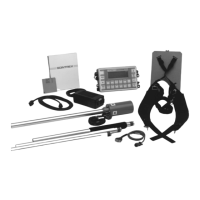Survey do’ s and don’ ts
ENVI-MAG Manual B3-7
Example
Search mode
Another useful survey mode for the rapid detection of near-surface ferrous
objects is the search mode. This mode is a variation of the base-station mode with
the data being displayed on the instrument screen as it is collected. This can be
very useful for metal ordnance detection. A detailed explanation of using this
mode is explained in the operations manual on page A5-13.
Note taking
Recording field information, i.e. notes, is very important for the subsequent
interpretation of the magnetic survey results.
Typical cultural features that should be noted are: fences, power lines, surface
debris, roads and buildings. These features should be noted when they are in
close proximity to the point at which you are taking a reading.,You are then
relating the disturbance in the magnetometer data with a specific cultural
feature. If this is not done, and you don’t happen to remember what was present
at the specific location, you run the risk of having the cultural feature mistaken
for a real anomaly.
The taking of notes is done quite easily with the ENVI-MAG using the “NOTE” key.
You can pre-enter a choice of five cultural noise sources (macros) that you are
most likely to encounter during the survey. The complete description of setting
up this feature can be found in the instrument section on page A4-25.
Surveying in the WALKMAG mode
There are some very interesting features about the ENVI-MAG. First and foremost,
it is a true WALKMAG type magnetometer, with near continuous readings (every
0.5 seconds). This allows you to produce a continuous profile of your magnetic
data collected along the survey line. The WALKMAG mode of operation is best
performed with the sensor mounted on the back-pack. The WALKMAG feature
also allows you to update the major station locations. This updating is performed
manually when you cross the stations separated by the distance increment—each
10-metre station for instance.
The back-pack mounted sensor used during the WALKMAG mode is illustrated in
the following figure (Figure B-23)

